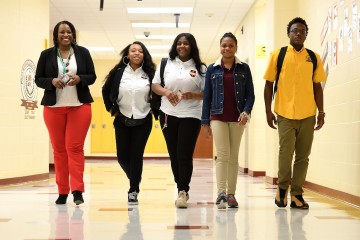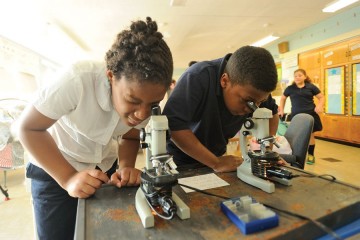The engineering lab at Baltimore's Patterson High School is a rare kind of classroom: A place where students voluntarily spend time even when there's no class.
"Sometimes I have to kick students out of here at 6 p.m.," says Sharon Ball, who teaches engineering and technology courses in the lab but also keeps it open for students to come by in their free time, at lunch and after school. Those who gravitate here, she says, want more time with science projects—writing code, building robots, dismantling laptops, and more.
On a Wednesday morning this month, a group of 16 juniors and seniors came to Ball's lab for a special purpose—the STEM-LEADS workshop series, run by Johns Hopkins University undergraduate students.
Image caption: At a recent STEM-LEADs session, students designed their own circuit boards.
The program has dual motives. The first is to expose Patterson students to hands-on work in the STEM (science, technology, engineering, and math) fields, through interactive experiments in neuroscience, physics, and other scientific disciplines. But in pointing to that potential career path, the program also addresses the part that comes first: higher education. The Hopkins volunteers offer college prep support, helping their younger peers navigate the challenges of test-taking and applications.
STEM-LEADS grew out of the Latino pre-health honor society at Johns Hopkins, Lambda Epsilon Mu. The group's president, neuroscience major Julia Duvall, developed the idea last year with fellow LEM members Diego Luna and Avery Gulino, winning support from the Johns Hopkins Idea Lab's Diversity Innovation Grant program, the Student Government Association, and the Whiting School of Engineering. The program debuted at Patterson in the spring, with Ball serving as faculty adviser.
At a recent session—before Patterson students paired off to design their own circuit boards—the seniors in the group were assigned individual mentors from Hopkins for help with college application essays.
"Nov. 1 is your first college deadline," Duvall reminded them, then went on to brief the high-schoolers on plans for a field trip JHU's Homewood campus. "The main point is that you guys get a feel for what college life is like."
Video credit: WMAR-2 News
In an interview, Duvall emphasized that the college prep aspect of STEM-LEADS is particularly vital at Patterson, where the four-year graduation rate was just under 60 percent last year, and, according to information provided by school administrators, roughly 40 percent of the school's 185 seniors did not take the SAT.
The high school—located in East Baltimore, near Johns Hopkins Bayview Medical Center—also stood out to STEM-LEADS organizers for its diversity, with a student body that speaks more than 32 languages. Its large Latino population—more than 40 percent, one of the highest among Baltimore City public schools—was of particular interest to members of Lambda Epsilon Mu.
STEM-LEADS organizers were also drawn to Patterson because of its strong STEM culture.
Ball, who has taught at the high school for 12 years, says that while Patterson may not garner the same attention or have the same resources as schools like Baltimore Polytechnic Institute and Digital Harbor High School, many of its students are talented and motivated in these subjects. Patterson Principal Vance Benton is also a "big supporter of STEM," she adds.
A few years ago, a group of Patterson students visited the White House with their design for a solar-powered hovercraft, and two of Ball's former engineering students have a patent for a desoldering tool they invented, she says. Just recently, the Technology and Engineering Education Association of Maryland (TEEAM) recognized Patterson for its exemplary engineering program.
Image caption: The STEM-LEADs program debuted at Baltimore's Patterson High School in the spring of 2018, exposing students to STEM fields through interactive experiments.
Margaret Hart, the STEM outreach adviser for the Center for Educational Outreach at Johns Hopkins, says she "knew of Ball from her robotics work in the city" and helped STEM-LEADS make that connection last year.
For the current school year, about a dozen volunteers from Hopkins are guiding STEM-LEADS classes at Patterson and also offering virtual assistance through emails and Skype. Most are neuroscience and engineering majors, Duvall says, including members of the Hopkins chapter of the Institute for Electrical and Electronic Engineers.
At a recent session at Patterson, three Hopkins students started their lesson, an engineering design project, with a primer on the concepts of voltage, currents, and resistance. But they deliberately kept the lecture brief.
"You'll get to build something today," JHU senior Sam Spetalnick assured the Patterson students. "That's what engineering is really about."
Posted in Science+Technology, Student Life, Community










